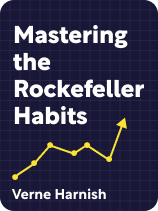

This article is an excerpt from the Shortform book guide to "Mastering the Rockefeller Habits" by Verne Harnish. Shortform has the world's best summaries and analyses of books you should be reading.
Like this article? Sign up for a free trial here.
What makes your company truly unique in your market? How can you protect that uniqueness from competitors who want to copy your success?
According to entrepreneur Verne Harnish, a brand promise represents the distinctive value that sets your business apart from others. Understanding and leveraging this promise effectively can help you dominate your market and build lasting success.
Read on to explore how to identify, develop, and protect your company’s unique advantage in ways that keep you ahead of the competition.
Your Brand Promise
It’s not enough to identify your company’s BHAG—you also need to come up with a plan for how to get there. To do this, Harnish says that you need to determine what unique value your company and (currently) no one else can deliver to the customer. Harnish calls this your brand promise. For example, a private tutoring service’s brand promise could be helping young students build motivation skills so they want to spend time studying.
Harnish explains that your brand promise helps your business succeed by giving it a competitive advantage. If you build your business strategy around your brand promise, you can dominate a competitive market.
(Shortform note: In Competitive Strategy, Michael Porter argues that delivering unique value isn’t the only viable way to gain a competitive advantage in your industry; rather, it’s one of three. Alternatively, you can gain an advantage by setting prices lower than anyone else or catering to a niche market within an industry. For example, if you sell tennis rackets, you don’t have to design a tennis racket that delivers more force with each swing than any others on the market. You could just streamline production so you can afford to lower the price, or design rackets specifically for left-handed people.)
Harnish says that, to come up with a strategy that will maximize your competitive advantage, ask yourself: How can you give your company sole control over your brand promise for as long as possible? In other words, what can you do to prevent your competitors from copying your brand promise? For instance, our tutoring company could extend enticing internship offers to all students at local universities interested in a tutoring career, then provide them with an internal career path. This way, there would be fewer skilled candidates available to work at other local tutoring companies.
(Shortform note: In Good Strategy Bad Strategy, Richard Rumelt suggests two ways to prevent competitors from copying your brand promise. First, use legal means: Patent proprietary technology and aggressively defend your trademarked branding. Second, rapidly innovate and improve your products or services so that competitors can’t move quickly enough to imitate you.)
How to Identify Your Brand Promise
According to Harnish, identifying your brand promise and building the capacity to capitalize on it is a significant undertaking that typically takes a company three to five years to accomplish. The first step is to identify what target market you intend to serve over the next three to five years: Who do you want your company to impact? How many customers do you want, and how large of a geographical area will you cover? (Harnish refers to these aspects of your target market collectively as your “Sandbox”).
(Shortform note: Although Harnish states that it’ll typically take you three to five years to get your footing in a target market, don’t shackle yourself to this timeline. In Playing to Win, A.G. Lafley and Roger L. Martin contend that many companies make the mistake of sinking money into a doomed strategy when pivoting to an alternative target market would make it much easier to turn a profit. If it becomes obvious that your chosen target market isn’t viable, pivot as soon as possible.)
Once you’ve identified your target market, brainstorm what unique value you’re going to offer by asking yourself what these specific customers need. Harnish notes that your brand promise will be a profitable advantage only if you focus on fulfilling one big customer desire—what they need rather than the countless little things they want. For instance, clients of the aforementioned tutoring company might want flexible scheduling, but they need to boost their child’s academic performance. For this reason, the company would prioritize imparting key motivation skills over perfecting their tutor scheduling systems.
| Counterpoint: Think About Customer Tasks, Not Needs In Competing Against Luck, Clayton Christensen argues that when deciding what to offer your customers, it’s more helpful to think about the tasks they need to accomplish rather than their needs. Thinking about general customer needs like “status” and “warmth” will reveal what they want on average, but tasks like “impress my friends when we’re out at a bar” and “provide shelter during my yearly camping trip” describe what customers truly need in specific situations. Thus, they’re a more accurate way to predict what customers will buy. For example, if you sell yoga mats, you might try to provide unique value by designing a mat that’s machine washable because customers need to keep their belongings clean. However, this isn’t a very convincing selling point—potential buyers aren’t thinking about how much they need to keep things clean. Instead, if you ask yourself, “What unique value can I provide customers who are trying to accomplish the task of motivating themselves to start healthy habits?” you might realize that yoga mat shoppers in that specific situation need a mat that comes with a free inspirational habit-tracking calendar. |

———End of Preview———
Like what you just read? Read the rest of the world's best book summary and analysis of Verne Harnish's "Mastering the Rockefeller Habits" at Shortform.
Here's what you'll find in our full Mastering the Rockefeller Habits summary:
- What an oil tycoon can teach you about business
- How knowing your business’s unique value is key to beating the competition
- Why you should create fun themes for your quarterly goals






